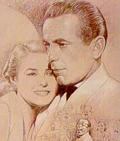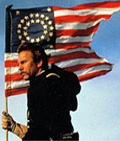|
Study Guide -
Gangs of New York (2002)
Director : Matin Scorsese
Stars :
Leonardo DiCaprio .... Amsterdam Vallon
Daniel Day-Lewis .... William 'Bill the Butcher' Cutting
Cameron Diaz .... Jenny Everdeane
Jim Broadbent .... William 'Boss' Tweed
Preparation :
Read the movie reviews by Roger Ebert, the New York Times , James Berardinelli and the article "Is Gangs of New York Historically Accurate?
"
Historical/Social Significance :
Includes historical figures such as William "Boss" Tweed and P.T. Barnum.
Depicted immigration and the anti-immigration forces, the New York City draft riots, corruption in Tammany Hall and Scorsese took his visual inspiration from Jacob Riis' "How the Other Half Lived".
"Butcher" Bill Cutting was modeled on Bill Poole, a leader of the nativists who abhorred the Catholic immigrants (particularly the Irish) pouring into NYC after the Civil War. Nativists in the 19th century were almost all Protestants who believed that Protestantism made America great, and that Catholics were a threat to the peace and prosperity of the nation. Dealing with the Great Immigration, slum-life of Manhattan in the beginning of American Industrialism, gang wars between Anglo-Saxon (Predominantly Protestant) natives and Irish (Predominantly Catholic) immigrants, early political corruption with Tammany Hall politics, and culminating with the New York Draft Riots during the Civil War.
"Certainly in terms of the visual images of the period, he's gotten that just right. The Five Points as depicted in the movie, 19th-century New York as visually depicted in the movie, he couldn't have done much better than that.
He also does a fabulous job of recreating the sense that the Irish and immigrants, in general, when they came to the United States in the 19th century did feel persecuted and were very much discriminated against, and he gets that theme very much right, too. " 3
" New Yorkers were very much ambivalent about fighting the war by 1863, especially because by then it had become a war not only to save the union, but to free the slaves. And New Yorkers were not very enthusiastic about fighting for African-Americans. So he does a very good job showing the rage of the mob; their animosity towards the fact that for $300 you could get out of the draft; their animosity towards African-Americans; how they took out their vengeance on the city's black population. " (Anbinder)
"Scorsese did a very good job depicting Boss Tweed, and particularly he shows how Tweed is somewhat ambivalent about the immigrants themselves, but decides very early on these are the people who represent the wave of the future in terms of the electorate. " (Anbinder)
Synopsis :
The story of Amersterdam Vallon, whose father is killed early in the film by nativist Bill "The Butcher". Amersterdam escapes, grows up and comes back to Five Points looking for revenge.
Guided Questions for Viewing :
Assessment questions will be based on the following :
-
Does Bill The Butcher have any redeeming qualities? (ones that would make him sympathetic to the audience)
-
Who is the most heroic character in the movie? What if his/her main motivation?
-
The draft riots were a main scene in the film. What motivated them?
- "Five Points' story, like that of "Gangs," shows that the making of the multi-ethnic America we know today was a lot more difficult than we remember. We tend to think that our ancestors were not like immigrants today, but in almost every way they were."2 Comment on this statement.
-
What was your favorite scene or sequence in the movie? Why did you like it?
-
" ... Scorsese's central theme that violence and corruption are integral to, and inseparable from, the American urban experience." 4 Discuss this theme with reference to the movie and what you know about the urban experience in America.
Sources:
1. Ebert, Roger. "Gangs of New York." Dec. 20, 2002. http://www.rogerebert.com
2. NYC Book Club. "Is Gangs of New York Historically Accurate?". Dec. 23, 2002. http://www.gothamgazette.com/article/feature-commentary/20021223/202/162
3. Anbinder, Tyler. "Gangs of New York" NPR Radio Show. http://hnn.us/comments/6212.html
4. Vanking, Jonathan and Whalen, John. Based on a True Story. Chicago : A Capella Books, 2005.
|



